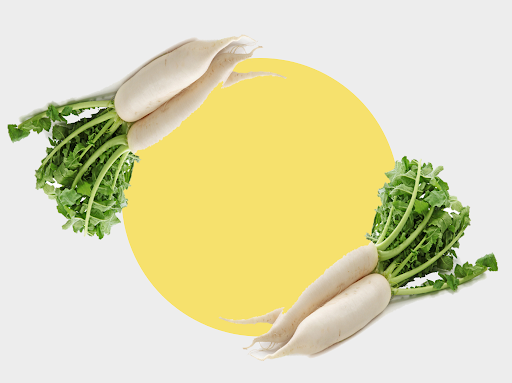Radishes are a low calorie vegetable that many people include in their healthy diet. But if you are diabetic, is low calorie benefit sufficient??
Lets understand, What are the health benefits of radish? Is radish good for diabetes? In our detailed article.
Radish: Nutritional Profile
Half a cup of chopped raw radish contains 12 calories, 4 grams of carbohydrates, 2 grams of fiber, 1 gram of protein, and virtually zero grams of fat. Radish is a rich source of vitamin C, so it is advised to eat ½ a cup of radish every day to ensure that your daily intake of vitamin C is as high as 15%.
It is also a good source of vitamin B6, vitamin K, potassium, folate, niacin, calcium, phosphorus, magnesium, zinc, copper, sodium, etc. With its low glycemic index level and being rich in antioxidants and minerals, it is considered one of the best veggies to have for a diabetic.
Advantages of Radish for Diabetes
- Radish contains compounds such as glucosinolates and isothiocyanates, which help regulate blood sugar levels.
- Eating radish can also increase the natural production of adiponectin in the body, which helps prevent insulin resistance.
- The high fiber content of radish roots aids digestion and releases sugar into the blood slowly and evenly, reducing the chance of sudden blood sugar fluctuations.
Ways to Consume Radish for Diabetes
If you’re uninterested in the ordinary radish recipes, right here are some clean dishes that you may assume of:
Radish Juice
Add half a cup of chopped radish in the juicer and blend them. Strain the collected juice into a bowl to remove any pulp or seeds. You can mix pepper and lemon if you wish to.
Cucumber-Radish Salad
Add ½ of a cup of chopped radish and ½ of a cup of sliced cucumber into a bowl. Whisk lemon juice, olive oil, salt, and pepper collectively and then pour over the salad. This appetizing salad will make you crave for it.
Radish Soup
Boil one cup of water and add ½ a cup of sliced radish to it. Cook the radish until tender. After 5 min, blend them into a mixer. Strain the liquid and add half a cup of water and boil once more for 15 minutes. Serve the soup hot topped with coriander and radish leaves.
Choosing the right vegetables can make a big difference in diabetes management. Dive into our guide on diabetes-friendly vegetables, their benefits, and the science behind how they help control blood sugar.
Best Time to Eat Radish
You can eat half a cup of radishes as a salad or snack at any time of the day. Radishes comprise sedative properties, so eating radish at night time will assist your body to wind down and relax. Well, it’s absolutely your decision!
Risks of Over Consumption of Radish
If you suffer from hypothyroidism or Hashimoto’s disease, keep your intake relatively low because radishes contain compounds that are known to reduce thyroid activity.
Other Health Benefits of Eating Radish
- Helps to lower high blood pressure and reduces cardiovascular risks
- Eliminates the risk of urinary tract infections
- Helps to fight against the free radicals and keeps the body safe
- Radish is good for weight loss
- Improve lipid metabolism
- Acts as a powerful detoxifier for the liver and stomach
Don’t Have Time To Read?
- Radishes are low in carbs and rich in vitamins and minerals with other essential antioxidants and micronutrients.
- Radish is rich in glucosinolates and isothiocyanates, which can help in regulating blood sugar levels and is a great vegetable for diabetes patients to have.
- It is advised to add half a cup of radishes to your daily diet plan in case you are a diabetic patient.
- It can be consumed in the form of radish soup, cucumber-radish salad, or in the form of a juice.
- It also has other health benefits, which can include lowering blood pressure and reducing cardiovascular risks, eliminating urinary tract infection, fighting against free radicals, and improving lipid metabolism.
Common FAQs
Is Radish Good for Diabetes?
Yes radish is a good food for diabetes patients to include in their diet. Radishes are a low-carb and low-calorie vegetable with a rich source of vitamins and minerals that helps to stabilize your blood glucose levels.
Are Radishes High in Sugar?
No. Radish has a low glycemic index level.
Is it Safe to Eat Raw Radishes for Diabetes?
Yes, it is. With its low glycemic index level, radishes help to stabilize the blood sugar levels in diabetic patients. Therefore, eating raw radishes is safe for diabetic management.
Can we Drink Radish Juice Daily?
Of course, yes. You must take this juice frequently in order to gain its healthy nutritional values over the long term.
Is Radish Bad for the Stomach?
No. Radish is possibly safe for maximum human beings whilst taken in mild quantities. Taking huge quantities of radish can aggravate the digestive tract. Some human beings are probably allergic to radish; however, that is rare.
Is Radish Good for the Liver?
Yes. Radish acts as an effective detoxifier for the liver. They are specifically right for those who are suffering from jaundice.
Can Type 2 Diabetics Eat Radishes?
Yes. Radishes considerably decrease the glucose induced postprandial glycemic load, suggesting that it is beneficial for diabetic patients.

1 comment
[…] Also Read: Is Radish Good for Diabetes […]